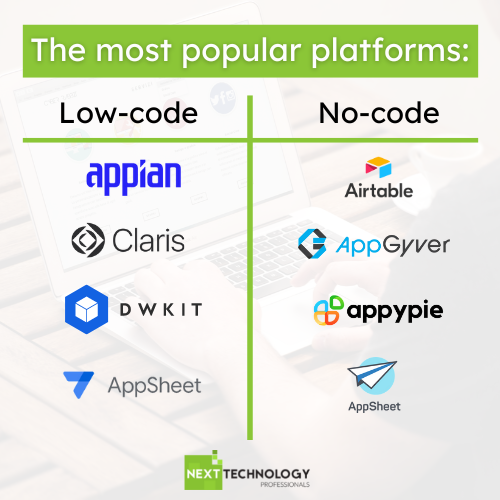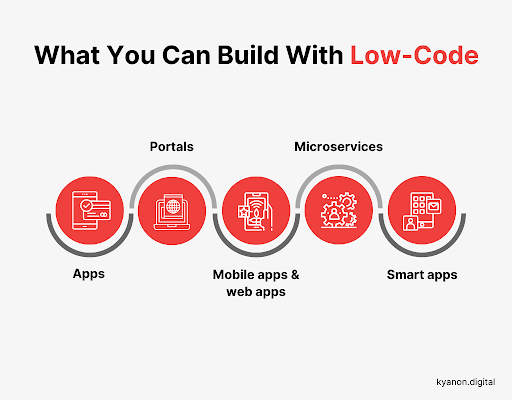Good Advice To Choosing Low-Code Platform Recommendations
Good Advice To Choosing Low-Code Platform Recommendations
Blog Article
Benefits Of Low-Code Application Development In Terms Of Integration Capabilities
Low-code development of apps has numerous advantages, particularly in terms of integration. This is essential in creating apps that effortlessly connect to platforms and services. Here are a few of the principal benefits that come with pre-built connectors and APIs.
A Wide Range of Connectors : Low-code platforms generally come with a huge library of prebuilt connectors to common enterprise systems (e.g. ERP CRM, databases, as well as cloud-based services). It makes it easier to integrate these systems.
API Integration: A lot of low-code platforms provide out-of-the-box API integration options, which allow developers to connect with external services and data sources easily.
Simple to use:
Drag-and--Drop integration Integration tasks are typically done using drag and drop interfaces. Developers and non-developers are able to set up complex systems that integrate without having to write code.
Visual Workflow builders Visual Workflow Builders used for designing workflows, data flow, and integrations. They help with understanding and setting up workflows more intuitively.
Standardized Integration Methods:
SOAP and Restful Services: Using standard web service protocols like SOAP or REST makes it simple to connect other systems and applications.
OData and other Standards Support for standards like OData allows easy access and manipulation of data on various platforms and software.
Real-Time Data Synchronization:
Real-Time Integrations: Low-code platforms are able to handle real-time synchronization between data applications, systems and databases. This will ensure that data is up-to-date and consistent within an company.
Event-Driven Architectural: Some platforms feature architectural designs driven by events, allowing applications to respond in real-time to events essential for dynamic, interactive applications.
Legacy System Integration:
Low-code platforms are frequently utilized to integrate older systems. This allows organizations to upgrade IT infrastructures without the need to completely overhaul the existing systems.
Data Migration Tools - Built-in data migration tools make it easy to move data from old systems to low-code applications.
Integration of Third-Party Services:
Integration with Cloud Services: Seamless integration with cloud services such as AWS, Azure, and Google Cloud allows for the simple deployment and scaling of applications.
Business Applications Integration: Low-code platforms can connect to various business applications, such as Salesforce, SAP, Microsoft Dynamics, etc., enabling a cohesive workflow across different business processes.
Simple Data Management
Unified Data Models A few low-code platforms offer unification of data models, which simplify the management of data and integrate across different systems.
Data connectors: Preconfigured data connectors give easy access and control to data from a variety of sources.
Security and Compliance
Low-code platforms make sure that integrations meet security protocols and standards, protecting data in transit and while it is in its rest.
Security Features: These platforms often include features which assure that integrations are in compliance with regulatory requirements, such as GDPR or HIPAA. This gives peace ofmind for businesses handling sensitive information.
Extensibility:
Low-code platforms can often accommodate complex integration requirements by adding custom code or scripts. They offer flexibility but without sacrificing their ease of use.
Plug-in Ecosystems: A plug-in ecosystem can be used to expand the capabilities of integration and permit users to add more features as needed.
Overall, integration capabilities within low-code applications development platforms allow them to provide a robust platform for creating connected, efficient, scalable, and interconnected applications. They facilitate the process of connecting disparate systems, enhance the flow of data and enable companies to take advantage of new technologies while leveraging existing ones. Take a look at the most popular here on Low-code Platform for application development for blog recommendations including ms azure sql, cross platform app dev, azure sql databases, no code platforms, push notifications, azure sql databases, application modernization software, sso azure, app development platform, sso azure and more.
Benefits Of Low-Code Applications In Safety And Governance
Low-code software offers a variety of benefits for governance and cybersecurity that are essential to ensure that all applications are managed, well-managed, and compliant throughout their lifecycle. These are the major benefits.
Unified Management Console - Low-code platforms provide a central management console for administrators to control and supervise the entire application. This ensures consistent governance throughout the organization.
Role-Based Access Control (RBAC): These platforms typically include an extensive role-based access control system, allowing administrators to define and enforce access policy. This ensures that only those with authorization can modify or access certain parts of the software.
Compliance and Regulatory Adherence
Many low-code platforms have built-in security features for compliance. They're designed to comply with industry standards and regulations such as GDPR and HIPAA. They offer tools and frameworks to help ensure that applications comply with these standards.
Audit Trails and Logging: Audit trails and logs that are comprehensive can be integrated to allow organizations to track changes as well as monitor access to ensure compliance.
Additional Security Measures
Data encryption. Low-code platforms provide encryption that is built into data both at rest and while it is being transmitted, which ensures sensitive information is protected.
Security Certifications: A lot of low-code companies have security certifications (e.g., ISO 27001, SOC 2) that demonstrate adherence to high security standards, providing extra security for users.
Automated security updates:
Regular Patching and Updating: Lowcode platforms usually provide regular updates to security. These patches safeguard applications against the latest threat without the need for developer intervention.
Security Monitoring Tools: These tools provide alerts in real-time and insights into security concerns that might be present.
Data Governance
Data Access Policies These platforms enable organizations to define data access rules and enforce them, ensuring data is only available to users who are authorized. They also make sure that the data is utilized in a proper manner.
Data Masking Anonymization The built-in tools for data masking and anonymization features help protect sensitive information, particularly in development and testing environments.
Consistent Application Lifecycle Management
Pipelines for Deployment and Development: Low-code platforms often provide integrated deployment and development pipelines that include security checks, ensuring that security is maintained throughout the application lifecycle.
Version Control - Integrated version controls helps track changes to applications and allows users to revert them, if required. They also maintain the integrity and performance of the software.
User authentication:
Single Sign-On (SSO). Support for advanced authentication and single sign-on is simple and improves security.
Multi-Factor Authentication: Many platforms have built-in support of multi-factor authentication. This adds an extra layer of security for applications.
Policy Enforcement and Compliance Monitoring:
Low-code platforms usually come with templates for policies that are pre-defined to allow organizations to establish governance and cybersecurity policies quickly.
Compliance Monitoring Tools - These tools provide continuous monitoring of compliance status and provide reporting, making it easy to identify and resolve possible issues.
Integration into Existing Security Infrastructure
Seamless Integration: Platforms using low-code are designed to seamlessly integrate with existing tools and infrastructure like SIEM (Security Information and Event Management solutions) and firewalls.
API Security API Security features make it possible to integrate with external systems, securing the integrity of data as well as ensuring the integrity of the applications.
Best Practices and Training:
Guided Best Practices: A number of platforms provide guidelines and best practices for developing secure applications that help developers who are not developers to adhere to security standards.
Security Training: Some low-code companies provide security training and resources to educate users on how to build and maintain secure applications.
All in all, low-code app developers offer security and governance advantage that allows them to build and manage their applications in a controlled, compliant and secure way. These platforms contain the tools and frameworks needed to supervise and control development of applications, as well as secure sensitive data, while ensuring regulatory compliance and enforcing policies. See the recommended Enterprise application development with Low-code Platform for more advice including application modernization, rapid app development, cloud software applications, microsoft azure sql, driver jdbc, rapid applications, microsoft azure sql, microsoft azure sql, lowcode no code, push alerts and more.
Community And Support From The Vendor Are Two Advantages Of Low Code Application Development.
Low-code applications development platforms can be an excellent method to gain support from the vendor as well as community participation. Both of these aspects are vital for ensuring an effective implementation and continuous maintenance of the app. These are the main benefits: Support
Comprehensive Technical Support:
Dedicated Support Teams: Many low-code platforms have access to support teams that can assist in technical problems, troubleshooting and guidance, ensuring that any problems are resolved promptly.
Some vendors offer 24/7 support. This can be very beneficial for businesses who operate across time zones.
Training and Onboarding
Formal Training Programs: Vendors typically provide a structured and organized training program which include webinars, tutorials and certification courses to help users get up to speed on the platform quickly.
Personalized Onboarding Many vendors offer customized services that help new clients to use their platform successfully and tailor it specifically to their needs.
Regular Updates, Enhancements, and Improvements:
Continuous improvement: Low-code platform providers generally release periodic updates which include the latest features, performance improvements as well as security patches, ensuring that the platform stays up-to-date and safe.
Feedback integration: Vendors frequently incorporate feedback from users during their process of development to make sure the platform is able to meet the changing needs of the users.
Comprehensive Documentation:
Detailed Documentation: Extensive and well-organized documents are usually available that covers everything from basics to advanced customization, which allows users to solve problems independently.
API References API documentation contains detailed API references to help developers integrate their low-code platform applications with other systems.
Consulting and Professional Services
Expert Consulting : Vendors provide consultation services such as designing architecture and complex implementations. They offer this service in order to make sure that their users are able to fully benefit from the platform.
Custom Development Services Some companies offer customized development services to build specific integrations and features that aren't available in the standard.
Community Support for the Community
Active User Communities
Discussion boards and forums Forums and discussion boards: Many platforms that are low-code feature a vibrant community where users can get help, discuss solutions, and work together to discover the most effective techniques.
Local and virtual user groups and Meetups, provide opportunities for users to share their experiences, share their knowledge with other users, and connect with.
Knowledge Sharing & Collaboration:
Community-Contributed Resources: Users often share templates, modules, and extensions that they have developed, which can be reused or adapted by others, accelerating development and innovation.
Crowdsourced Problem Solving: The collective expertise and experiences of the community can be an invaluable resource for troubleshooting issues and finding creative solutions to difficult problems.
Learning and Development:
Community-led training: Many groups hold workshops, sessions for training, and webinars. They are usually run by knowledgeable users who share practical knowledge and the most advanced methods.
Online Tutorials: The community members create and share many online tutorials, how-tos, and tutorials. These tutorials are available to all.
Feedback and Influence
Product Feedback: Many forums have channels for giving feedback to manufacturers. This feedback can affect the development of new features and enhancements.
Beta Testing members of active communities might be eligible to take part. This allows them to get early access to the platform and participate in the creation of the platform.
Recognition and Encouragement
Community Recognition Programs: A lot of vendors provide recognition programs for active members of the community. Some examples include MVP (Most Valuable Professionals) that recognizes contributions.
Peer Support: Members of the community frequently provide support to peers offering their expertise and providing guidance to less experienced users creating a more collaborative and supportive environment.
Overall, the combination is robust vendor and active and engaged communities. They provide an extensive environment to assistance with low-code development of applications. Users will be able get the help, resources and collaboration opportunities that they need in order to build applications, deploy, keep them up to date and improve their applications.